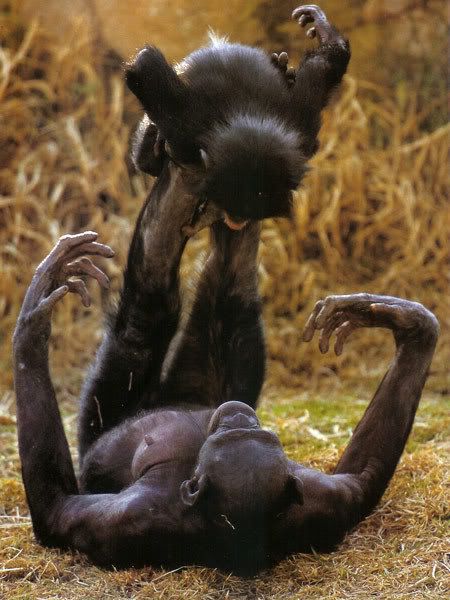

As part of the series of reposts leading up to my review of Frans de Waal's newest book The Age of Empathy: Nature's Lessons for a Kinder Society I present the first of three pieces that appeared after Ian Parker's 2007 article "Swingers" appeared in The New Yorker.
 As expected, the apologists for unreason who promote Intelligent Design have jumped on the recent article in The New Yorker about bonobos. This inspired me to write at more length about the article since this is a species I've studied closely for the last two years. Denyse O'Leary at Uncommon Descent uses the article to proudly declare that "Apes R Not Us, and we have to get used to it."
As expected, the apologists for unreason who promote Intelligent Design have jumped on the recent article in The New Yorker about bonobos. This inspired me to write at more length about the article since this is a species I've studied closely for the last two years. Denyse O'Leary at Uncommon Descent uses the article to proudly declare that "Apes R Not Us, and we have to get used to it."
First off, even if bonobos turned out to be the most vicious beasts ever to be described by humankind it wouldn't change the fact that we share between 98.6% to 99.4% of our DNA with the genus Pan (the latter figure is based on genes responsible for brain tissue). We are apes, every last one of us hairless fools.
Second, while the popular view of bonobos has sometimes exaggerated their peaceful characteristics, The New Yorker article is being touted as though the reported bonobo social life has been a scientific fraud. As O'Leary states at her primary blog:
all along primatologists have had an agenda to try to prove that humans are not condemned to be brutes because bonobos are, like, nice.
There's a big difference between determining that popular misconceptions are incorrect and claiming that scientists are fabricating evidence. Gottfried Hohmann has been working for many years to try and uncover the mystery of the elusive bonobo. As reported this year in the journal Nature in reference to Hohmann's research:
Whereas violent encounters are the norm in the chimp society, conflicts such as that observed at Lomako are rare in bonobos. Perturbations to bonobos' social order are generally defused through sexual acts, often in homoerotic encounters between females.
There is a distinct difference between chimpanzee and bonobo social behavior, in the field and in captivity. As highlighted by bonobo expert Frances White and discussed in my article for Wildlife Conservation magazine, unrelated bonobo females will form cooperative partnerships to defend against aggressive males. This is unheard of in chimpanzees. Furthermore, it should be noted, that aggressive bonobos are positively timid when compared to chimpanzees in full battle mode.
However, The New Yorker article ignores this aspect of bonobo sociality to set up an ad hominem mode of argument. By attempting to show that Frans de Waal (who hasn't done field work with bonobos and has never claimed to) exaggerated bonobo cooperation they imply that such cooperation may not exist. This rhetorical approach may have worked with some of the more uncritical folk at Uncommon Descent, but you could build a monument with the crates of bad argument and misinformation that they employ on a regular basis.
For example, The New Yorker article makes a point of noting that captive bonobos could be more promiscuous than wild bonobos. Citing Craig Stanford, a primatologist I greatly respect:
Stuck together, bored out of their minds--what is there to do except eat and have sex?
However, if this were the case why wouldn't captive chimpanzees be doing the same thing? When you compare captive chimps and captive bonobos you find striking differences. But, assuming that captive animals are therefore bad examples, why would The New Yorker then use a captive example to suggest bonobos are just as violent as chimpanzees?
. . . at the Planckendael Zoo, near Antwerp. "I once saw five female bonobos attack a male in Apenheul, in Holland," he said. "They were gnawing on his toes. I'd already seen bonobos with digits missing, but I'd thought they would have been bitten off like a dog would bite. But they really chew. There was flesh between their teeth.
Couldn't one respond to this anecdote by saying:
Stuck together, bored out of their minds--what is there to do except eat and fight?"
I'm very pleased that The New Yorker has chosen to highlight bonobos and in general I think the article was very good. However, uncritical readers may take the author's approach of pushing controversy to attract attention (a tactic the Intelligent Design crew knows only too well) as demonstrating more than it has.
As more evidence comes in more will be known about our other evolutionary cousin. However, there is no disagreement among primatologists that bonobos are a unique species with characteristically unique social interactions, even among those who think the distinction has been exaggerated. As The New Yorker article highlighted from those who have spent the most time in the field:
"With bonobos, everything is peaceful," Takeshi Furuichi, a Japanese researcher who worked with Kano at Wamba, told me. "When I see bonobos, they seem to be enjoying their lives. When I see chimpanzees, I am very, very sorry for them, especially for the high-ranking males."
To paraphrase the 19th century evolutionary biologist T.H. Huxley, I only wish I was more closely related to either of these species than I am to the ignorant apes over at Uncommon Descent.

It seems a bit telling that the researchers that study bonobos in the wild go on about how peaceful they are, while the zoo keepers are surprised by their aggression. Right, take them away from their natural habitat, lock them up in a cage with nothing to do, and they attack their captors. Humans would never do that, would they?
Having done quite a bit of captive research with bonobos at multiple facilities, I can attest that they have a very low level of aggression. I had never even heard of bonobo violence like this before Parker's article, but it's fairly commonplace in captive chimpanzees.
But, yes, I would imagine that aggression is increased for both species when in captivity.
I have recently worked with a group of bonobos and though they were generally peaceful, I was unfortunate enough to witness the horrific injuries they can inflict on one another in a captive environment. Had these attacks not been disturbed, I can not be sure that the group would have spared the life of their victims. I do not believe we can paint them a rosey picture nor an aggressive one, like people, their behaviour is down to circumstance and individuals.
I have recently worked with a group of bonobos and though they were generally peaceful, I was unfortunate enough to witness the horrific injuries they can inflict on one another in a captive environment. Had these attacks not been disturbed, I can not be sure that the group would have spared the life of their victims. I do not believe we can paint them a rosey picture nor an aggressive one, like people, their behaviour is down to circumstance and individuals.